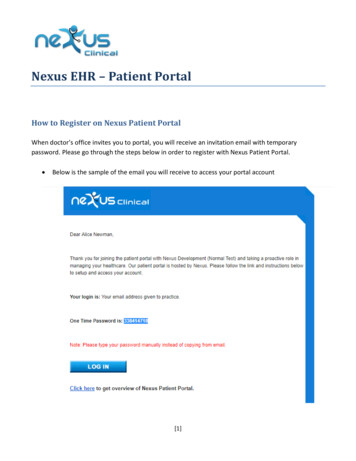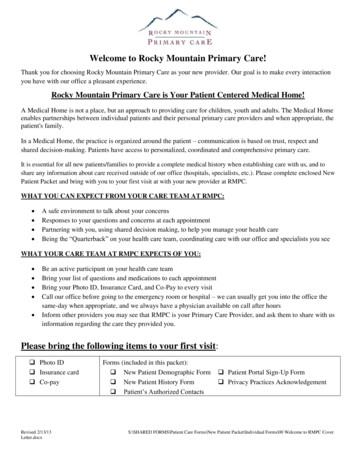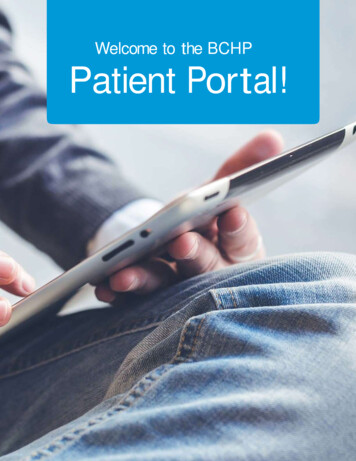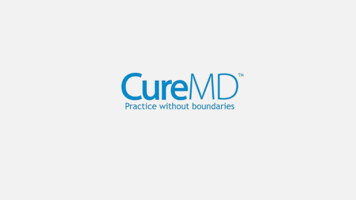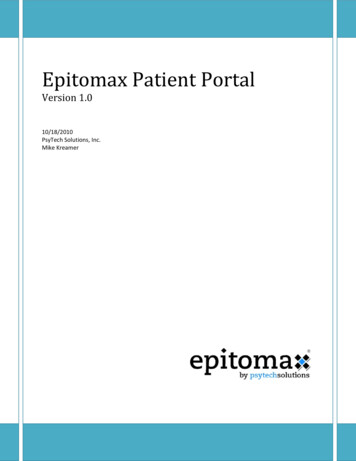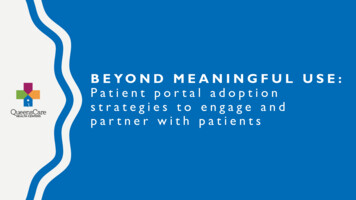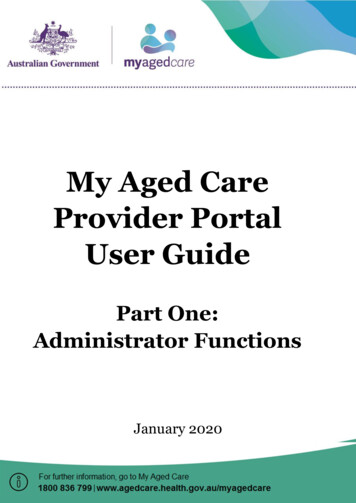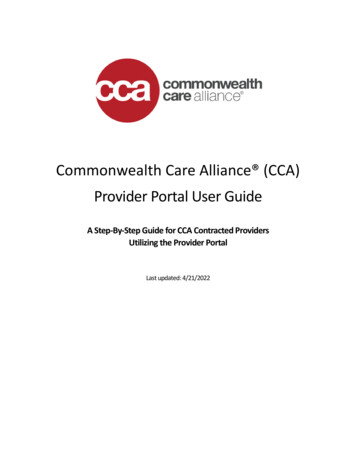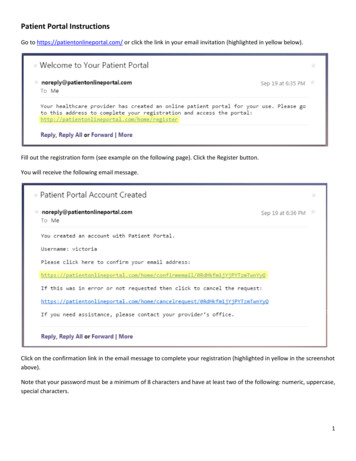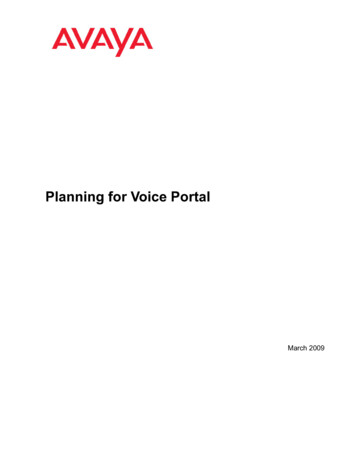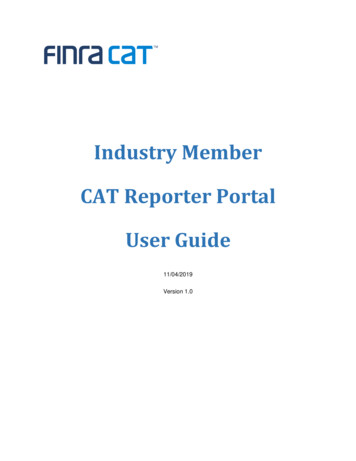
Transcription
What Can a Patient Portaldo for My Practice?Research and Real Life1
Collaborative, online, healthcare services Approximately 45 percentof medical practices in theUnited States havepurchased some form of aclinical portal solution How many are using them?2
From our Leaders . The transition from volume-based to value-based care requires patient communicationsmodalities that respond to the new alignment of care incentives In the not-too-distant future, patients may send you pictures or video showing themperforming prescribed rehabilitation exercises or function tests for you to evaluate.Surgical patients might send you photos of the surgical incision site so that you canmonitor for postoperative infections Using a patient portal for effective, timely communications can increase your efficiencyand productivity.3
Would You Use a Portal? Who banks online? Books travel? Reservations? Facebook? Why? Convenience and reduce time spent and costsPatient portals, however, represent an opportunity for patients and clinicians to worktogether to achieve improved health outcomes through coordination of care, sharing ofpertinent data and records, and continuous tracking of patient health indicators (e.g.,blood-pressure and glucose levels)4
Power Shift with Risk Clinicians will no longer be the gatekeepers of health information Costs are responsibility of the practice Inherent responsibility on the part of healthcare organizations: ensuring that appropriateresources and education tools are available Non-reimbursable Empowering patients is an important element of the patient centered care and MUmovements Patient has an educated voice Patient has more access to provider5
Risk?May 1 2014 Attestation figures CMS's Office of eHealth Standards and Services 50 of the 225 eligible professionals that have attested for the 2014 reporting yearhave done so for Stage 2; and Just four of the 30 eligible hospitals that have attested for the 2014 reporting yearhave done so for Stage 2 However, meaningful use registration has reached: Nearly 95% among hospitals eligible for the Medicare program; 57.8% among health care professionals eligible for the Medicare program; and 28.9% among those eligible for the Medicaid program6
Functionality AppointmentsView their lab resultsRequest prescription refillsView personal health record and visit summariesReceive educational materialsSend and receive secure e-mail messages to and from clinic staffComplete intake forms (medical, social, and family history)Receive appointment and health remindersView past billing statements and pay current amounts dueUpdate demographic information as it changesView and request referrals7
Value Proposition Completing intake forms electronically, in the comfort of their home Can find medication names Automatically imported into the patients' progress note in advance of their appointment Demos, MU, History, questions Rural patients have a more effective communication mediumChronic diseases are easier to manageResearch accessPersonal record keeping (compliance)8
MU Require a Portal? Core Measure 12- Provide patients with an electronic copy of their healthinformation (including diagnostic test results, problem list, medication lists, andmedication allergies) upon request Menu Set Measure 5-Provide patients with timely electronic access to their healthinformation (including lab results, problem list, medication lists, and medicationallergies) within four business days f the information being available to the eligibleproviderReplaced with in Stage 2 Core Measure 7-Provide patients the ability to view online, download, and transmittheir health information within four business days of the information being availableto the eligible provider Core Measure 13- Provide clinical summaries for patients for each office visit9
CORE Measure – 7 - Patient Electronic Access toHealth Info WorkflowExample (from Kryptiq Patient Portal) – Once exported by provider,patient can view their chart online and transmit to a 3rd party.10
CORE Measure – 7 - Patient Electronic Access toHealth Info Changed in Stage 2 (Moved fromMenu to Core)Measure – 2 measures combined into 1 Change from 10% of all patients of the EP have timely access to their healthinformation within 3 business days to: 50% of all unique patients seen bythe EP during the EHR reporting period are provided timely (available to thepatient within 4 business days after the information is available to the EP)online access to their health information Change from 50% of all patients of the EP who request an electronic copy oftheir health information are provided it within 3 business days to 5% of allunique patients seen by the EP during the EHR reporting period (or theirauthorized representatives) view, download, or transmit to a third party theirhealth information11
CORE Measure – 12 – Patient RemindersWorkflowAfter configuring and running an inquiry to identify a list of patient, select SendReminder in the Activity list to set up and print a reminder letter (form the“Actionable” folder) for each patient.12
CORE Measure – 13 – Patient-SpecificEducation Resources Changed in Stage 2:(Moved from Menu to Core)Measure Changed from 10% of all unique patients seen by the EP are providedpatient-specific education resources to patient-specific education resourcesidentified by CEHRT are provided to patients for 10% of all unique patientswith office visits seen by the EP during the EHR reporting period.Workflow Use Info button to look up and/or print patient/context-specific educationmaterials for medications, problems, and lab results.Configuration Info button vendor must be configured in Setup/Administration13
CORE Measure – 17 – Secure ElectronicMessaging New in Stage 2Measure A secure message was sent using the electronic messagingfunction of Certified EHR Technology by more than 5% of uniquepatients seen during the EHR reporting period.Workflow Use a supported Secure Messaging integrated application.14
CORE Measure – 17 – Secure ElectronicMessaging ConfigurationKryptiq Secure Messaging15
Clinical Quality Reporting (CQR)Use CQR forsubmission toCMS/state Use CQRdashboard tovisualize howeach provider isperforming relativeto eachFunctional/ClinicalQuality Measure16
PCMH Standard 1- Enhance Access andContinuity1.2.3.4.5.6.Electronic copy of health information within three days to more than 50% ofpatients who request it (correlates with meaningful use Core Measure #12)Electronic access to current health information within four days to at least 10% ofpatients (correlates with meaningful use Menu Measure #5)Clinical summaries provided for more than 50% of office visits within three days(correlates with meaningful use Core Measure #13)Two-way communicationRequest for appointments or prescription refillsRequest for referrals or test results17
Key Lessons Learned Planning Implementation Workflow18
Policies – In Writing! Adolescents who seek care independent from their parents, particularly sensitivereproductive-related health care Have the same expectations and rights Ensuring confidentiality for these minor patients introduces a high level of complexity tohandling Practice response time Who, when Privacy and Security Sensitive issue management Certified portal and messages Procedures for monitoring the portal and include a clear disclaimer regarding monitoring Patients who attempt to use the portal for emergencies should receive an alertnotification19
Planning Drivers -MU, PCMH, Payment ReformBenefits-Save staff time-appointment requestsBarriers–Digital Divide, Language, Literacy-patient populationAnalyzing these factors in the context of your practiceActionable and measurable parts with clear accountability for eachHard and soft costsIs portal a good name?What will you use it for?20
Workflow Who can help enroll the patient? Documentation to meet measures Pre-completed forms What I want to discuss with my doctorDemos and insuranceHX and FHMU questions Message management Does a doctor have to manage a patient message? Monitor patient outcomes and track recovery between office visits -may alsoimprove patient satisfaction21
Implementation Patient engagement is key Enrollment process Marketing materials — posters,pamphlets, buttons, slide shows,and videos on monitors in thewaiting room —direct staff orprovider outreach Messages while on hold-you canrequest appointment or get resultson portal Advanced capabilities Training patients and staff22
Success stories Kaiser Permanente, which has one of the most expansive patient portal deploymentsin the nation, reports that 53.3% (218,456) of eligible members in its Northwestregion were registered patient portal users. VA- My HealtheVet -make informed decisions and manage your health care American Academy of Family Physicians, 41 percent of family practice physicians useportals for secure messaging, another 35 percent use them for patient education,and about one-third use them for prescribing medications and schedulingappointments23
Use Case Rheumatology Impact of patient-accessible electronic medical records in rheumatology: use,satisfaction and effects on empowerment among patients 54% of respondents with Internet access had viewed their EMR Respondents were positive about the ease of use and usefulness of the portal andreported very few problems 44% reported feeling more involved in their treatment 37% felt they had more knowledge about their treatment24
Use Case Cancer Using a Patient Portal for Electronic Communication With PatientsWith Cancer: Implications for Nurses Electronic communication with patients presents an opportunity to move away fromthe idea of a patient visit being a single in-person event to an ongoing relationship In the outpatient setting, oncology nurses care for patients along the entire carecontinuum—from diagnosis, through treatment, and to survivorship or death The incorporation of secure messaging to oncology practice offers nurses and patients aunique alternative that allows more frequent and timely communication between nursesand patients25
Alliance for Nursing Informatics Pledge toSupport Consumer eHealth 2013Nurses are the most-trusted health professionals and have a long history of patient advocacy.We expect nurses to have a significant impact on consumer participation in Health IT toincrease use of Personal Health Records and Patient Portals from 10% today to over 25% in thenext 2 years.26
GE Solutions Integrated for more advanced functionality Kryptiq Portal and Secure Messaging Numerous other HIEs and Portals connected27
Kryptiq Chart Summary28
Kryptiq Pin Generator29
N ORTH M ISSISSIPPI H OSPITAL C ENTERPatient Portal ExperienceLori Pruitt, MIS Physician Analyst Supervisor
W HO W E A RE» North Mississippi Health/Medical Center cover 24 counties in northMississippi and Alabama» North Mississippi Medical Clinics is a network of more than 30 primaryand specialty clinics; and nursing homes» Our main focus is to provide convenient access to quality health care» NMHS is a 2012 recipient of the prestigious Malcolm Baldrige NationalQuality Award31
W HO IAM» North Mississippi Health/Medical Center cover 24 counties in northMississippi and Alabama» I manage a team of nurse informaticists that mange all MU, PCMH, andregulatory issues, as well as training and testing of applications» I manage multiple platforms for our EMRs, as well as HIE and portalservices32
H OW W E D ID I T»»»»ApproachProcess ChangesResourcesWhat I would do Differently?33
Thoughts?Paula Infeld, RN, CPHIMSSage Growth PartnersPinfeld@sage-growth.comLori PruittMIS Physician Analyst SupervisorLPruitt@nmhs.net34
References/Resources Baird, A., Furukawa, M. F., & Raghu, T. S. (2012). Understanding Contingencies Associated with the EarlyAdoption of Customer-Facing Web Portals. Journal Of Management Information Systems, 29(2), 293-324. Goldzweig, C., Orshansky, G., Paige, N. M., Towfigh, A., Haggstrom, D. A., Miake-Lye, I., & . Shekelle, P. G.(2013). Electronic Patient Portals: Evidence on Health Outcomes, Satisfaction, Efficiency, and Attitudes. Annals OfInternal Medicine, 159(10), 677-700. Dooling, J. A. (2012). It's About the Patient: Engagement through Personal Health Records and Patient Portals.Journal Of Health Care Compliance, 14(2), 33-34. Utilizing Patient Portal Functionality within an EMR System Louiselle, Paul, MA. The Journal of Medical PracticeManagement : MPM28.3 (Nov/Dec 2012): 183-6. Tomsik, E., & Briggs, B. (2013). Empowering patients through advanced EMR use. Health Management Technology,34(3), 14-15. van der Vaart, R., Drossaert, C., Taal, E., Drossaers-Bakker, K., Vonkeman, H., & van de Laar, M. (2014). Impact ofpatient-accessible electronic medical records in rheumatology: use, satisfaction and effects on empowermentamong patients. BMC Musculoskeletal Disorders, 15102. doi:10.1186/1471-2474-15-102 Rodriguez, E. S. (2010). Using a Patient Portal for Electronic Communication With Patients With Cancer:Implications for Nurses. Oncology Nursing Forum, 37(6), 667-671 MEVIS, H. (2013). Connecting With Patients Through Portals. AAOS Now, 7(10), 29. http://www.chcf.org/patient-portals Electronic copies of all marketing materials are available on the CDC Web site pport/1-2-3-approach35
PCMH Standard 1-Enhance Access and Continuity 1. Electronic copy of health information within three days to more than 50% of patients who request it (correlates with meaningful use Core Measure #12) 2. Electronic access to current health information within four days to at least 10% of patients (correlates with meaningful use Menu Measure #5) 3.
